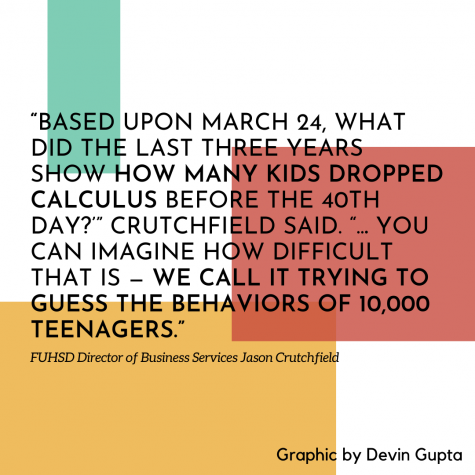Graphic by Rachel Jiang
Plotting the Future
Examining course allocations at MVHS through the lens of declining enrollment
April 1, 2021
Part 1: The Problem
Investigating how declining student enrollment at MVHS has affected course allocation
For many years, declining enrollment has been a trend at MVHS and across most of FUHSD. An enrollment projection report written by Thomas R. Williams, the Principal Demographer for Enrollment Projection Consultants, projected MVHS would lose 102 students in the 2021-22 school year.
According to Williams, this annual pattern of declining enrollment can be attributed to two major factors: the high housing prices in the Bay Area and recent modifications to the interior designs of homes. Housing in the Bay Area is now more suitable for young tech employees; this consists of various studios and one-bedroom units. These factors lead to fewer families with children settling in, which decreases the number of students who attend FUHSD schools.
Additionally, assistant principal Michael Martinez points to trends of declining birth rates as another reason for declining enrollment. From the 2020-2021 school year alone, student enrollment has even dropped at the kindergarten grade level. By the time those students become high schoolers, Martinez projects that the student population will have dropped even further. Williams predicts the MVHS student population will be around 1,855 students by 2022-23 (two years later) and 1,619 students by 2025-26 (five years later).
With a dwindling population of students at MVHS, FUHSD school administrations are forced to cut sections of courses, or different sessions of the same course, for future school years, as the criteria for expected student to teacher ratios have not been met.
If section cuts continue to occur, classes with fewer sections would be at risk of being permanently removed from the MVHS course list. Martinez reassures that no entire classes have been cut so far in recent years.
According to the MVHS 2020-21 course allocation, from 2019 to 2020, MVHS administration cut a total of 34 sections from the 394 sections a year prior. Due to declining enrollment, classes have steadily been losing sections year after year. From the current 2020-2021 school year with a total of 360 sections, each year is predicted to lose around 25 sections every year projecting 335 sections for the 2021-22 school year and 310 sections for the 2022-23 school year.
Since the quantity of sections per course depends on the amount of student interest for each course, the number of sections offered for a certain class varies annually. However, according to Martinez, STEM classes typically remain popular choices. Thus, the risk of them being completely cut is much lower.
Nonetheless, all sections, including science and math classes, face the almost same number of section cuts every year. Though, popular courses such as Java and AP Biology will not face as large of an impact when sections are cut. Classes that are less popular, such as AVID and Drama, tend to face more risk when their sections are removed as they originally had fewer sections available.
Ceramics and Photography teacher Jodi Johnson states that when she first started teaching at MVHS 16 years ago, there were five art teachers who each taught five sections for a total of 25 art sections. Now, there are three art teachers who each teach five sections, which is a sharp decline in total art sections offered covering around 10 different art forms.
To promote the different courses offered at MVHS, an annual course selection night and course info fair occurs in February. This year, due to COVID-19, these sessions were shifted online via Zoom and YouTube to reach as many students and families as possible. In order to learn about specific classes, students had the opportunity to visit teachers through Zoom and the information about all classes was listed on a spreadsheet. Sophomore Tulasi Janjanam believes that attending these webinars was a huge asset to her course selection.
“Since there were a lot of courses and a lot of options, I had to go through all of them, look at what I needed and the course info fair really helped because I got to talk to the teachers and [knew how the class] is actually going to work,” Janjanam said. “The positive thing is some of them, there weren’t a lot of people. So me and the teacher had a one on one and they actually showed me what was gonna happen next year [and] what [a] class was about.”
Unlike Jananam, who was able to receive guidance from teachers from different subjects over the Zoom course info fair, senior Sawyer Day felt as though these information sessions were not as helpful throughout his time at MVHS.
“I feel like the [teachers] still don’t give you that much information on how rigorous the courses are going to be,” Day said. “They give the general idea of the content covered, but you can’t really know exactly how it’s going to be until you take it. It’s much different throughout the year. They give an estimation, but it’s not consistent [for] the entire year. So I generally just ended up taking [the courses] I was recommended by my friends, peers or my older [siblings].”
Day found it difficult to choose his STEM and English classes because he wanted to maintain an academically rigorous course schedule next year, but did not feel prepared. Although Day took 3D Design primarily as a way to receive his art credits, he says taking an art class junior year helped relieve stress.
Johnson notes that art allows students a place to learn not only art skills but many life skills as well. She emphasizes how art courses can provide freedom of creativity, which is something STEM classes may not necessarily provide.
“It’s [a] fun environment, it is loose, you get to express a different part of your brain that doesn’t work all day and it’s nice to also have that creative release in your day,” Johnson said. “It’s nice to have that kind of stress break and you get to talk with your tablemates, and you’re still doing something that is mindful and engaging, but in a totally different way. You’re getting a lot of problem solving skills and critical thinking, and it’s also really good for self discovery and you tend to learn more about yourself through some projects.”
Part 2: The Process
Examining how MVHS makes course allocation decisions
From 2008 to 2010, MVHS enrollment peaked at 2,600 students, with an average class size of 700. For the 2021-2022 school year, enrollment is projected to be 1,913, according to Principal Ben Clausnitzer.
Every December, FUHSD Demographer Thomas R. Williams shares the next year’s resident enrollment projections, which means where students live in the district, with FUHSD Director of Business Services Jason Crutchfield. Crutchfield converts the resident projection into attending enrollment, the number of students per FUHSD high school, taking into account transfer programs and special education.
The attending enrollment calculates each school’s target section allocation — the total number of sections (class periods) allowed — according to a formula agreed upon with the Fremont Education Association (FEA) union, which includes all certificated FUHSD staff. MVHS’ target section allocation is 335 for the 2021-2022 school year.
After students turn in their course selection forms in February, the scheduling assistant principal (SAP) at each school works with the departments and Crutchfield at the district level to develop a master schedule. The SAP at MVHS, Michael Martinez, then predicts the course enrollment on the 40th day of school for the next school year, one week after the first progress report is issued. This is because students often drop classes during the first few weeks of school and near the first progress report.
“Based upon March 24, what did the last three years show how many kids dropped calculus before the 40th day?’” Crutchfield said. “Well, it shows 19 [students] dropped. Then I better have 19 more [students] than I need, so if they drop, we’re going to hit our mark. You can imagine how difficult that is — we call it trying to guess the behaviors of 10,000 teenagers.”

Class size or teacher to student ratios, which are determined through negotiations with the FEA, determine how many sections of each class will be offered. According to Bonnie Belshe, FEA Site President for MVHS, this is outlined in the Collective Bargaining Agreement (CBA), which sets workplace conditions. It also defines safeguards like the minimum and maximum number of students per class.
The CBA allows for some flexibility with understaffing and overstaffing. For instance, fully tenured teachers are currently given a full-time job regardless of declining enrollment, though it may not be at their current school site. Additionally, the district administration checks whether schools can share a teacher through a split assignment or if teachers can teach another subject or take on another role at their own site.
If there are extra sections in a department when all teachers are working full-time (five classes per teacher), department leads like Belshe, who leads the Social Studies department, scouts for other teachers in the district to pick up the extra section at MVHS. This year, history teachers Robbie Hoffman and David Hartford are both teaching six classes with increased salaries since there were two extra sections of U.S. History.
In contrast, when the formula generates a decimal number of sections or results in a section with too few students, the schedulers try to round down, minimizing the number of sections. Crutchfield says that “people don’t realize that [creating sections] adds up to millions and millions and millions of dollars a year,” given that each costs $25,000 to $35,000. If each school in the district adds one extra section to the master schedule, the costs come close to $1.5 million.
“If we offer nine sections of Algebra 1 and we only need eight, I’m going to tell [the math department], ‘You have to close one of those classes and redistribute those kids and change all their schedules,’” Crutchfield said. “It’s miserable work. No one wants to go to a parent and a bunch of students in the fourth week [of school] and say, ‘Hey, we’re rearranging your entire schedule and changing your classes, so you can go to a bigger class.’ But that’s $30,000 so we force ourselves to do it.”
Once each department has a target number of sections, schedulers look at specific course signups by working in Infinite Campus, and department leads narrow the department section allocation to specific course allocations. According to Crutchfield, MVHS frequently faces over enrollment for the following school year and loses 30-40 freshmen in the fall who move elsewhere. SAPs accommodate this particularly in math, science and modern language classes, the three areas with the largest amount of drops during the school year.

“People say, ‘Why don’t we get our schedules until the first day?’” Crutchfield said. “We’re making changes, all the way up until that morning. We’re making changes [because] new kids enroll, new kids drop every day of the year for us.”
Generally, after dividing enrollment by target section allocation, each student at MVHS is allocated 6.13 classes, with fluctuations across grade levels. According to Crutchfield, it would cost the district five to 10 million dollars annually if all students got all seven choices on their course selection forms. Instead, the seventh period helps students make up for failed classes to graduate in time and make room for English Learner (EL) students who are required to take extra classes. The entire process only targets general fund classes, paid for by property taxes; sheltered EL classes are not involved. Crutchfield says to “think of it as seven opportunities to take six classes.”
With this flexibility at the micro level, schedulers prioritize placing singleton and doubleton classes — where there is only one or two periods for that specific course — and fixed period classes such as American Studies, World Studies and sheltered classes. According to Belshe, schedulers have to navigate specific student constraints such as a student taking the AP level of a foreign language and Journalism, both of which are singleton classes that are only available in a specific period.
“The doubleton, singleton day, [is] actually one of my favorite days of the whole process, because it is so focused on the students and getting students the maximum access to what are very specialized courses,” Belshe said. “[We consider] how can we create this puzzle to put these pieces together to give [students] the most access to take all [the classes] that they have signed up for.”
Crutchfield, who was previously a SAP, says that he always reminded students that “you won’t get every class you want every year. It just doesn’t work that way. But you will get it [eventually].” He emphasizes that popular classes like Engineering may take a couple years before a student can successfully get it in their schedule since courses in the seventh choice on the course selection form are not guaranteed.
“You’ll get to college and realize how much easier it is in high school to get the courses you want,” Crutchfield said.
Even at the high school level, scheduling conflicts don’t work out for every student, according to Clausnitzer.
“[If] we’ve got one student who has [two conflicting singleton classes], we have to go talk to this student and tell them that [they] can’t take two classes during one period and they’re going to have to make a choice,” Clausnitzer said. “That’s the most complicated part of [course selection].” – Principal Ben Clausnitzer
In the past, FUHSD has made some changes to the process. They’ve taken students in sheltered classes out of the general class ratios, decreased freshman math class ratios from 32.5 to 23 students per class, decreased music class size ratios from 40 to 36 and guaranteed every school 10 sections of music. Every three years, FEA and FUHSD have the opportunity to negotiate a new contract but don’t change ratios due to the hefty costs involved. However, Crutchfield foresees that the district may be overstaffed enough next year that the teachers will agree to a temporary ratio reduction.
“Overall, our financial health is really preserved, a lot of it is by this process,” Crutchfield said. “And the healthier [the district is] financially, the more resources there are for students, the more resources there are for our staff members. We are in wonderful financial shape in the last three years. We’ve given 2-5% raises [to staff] the last three years in a row.”


